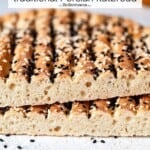
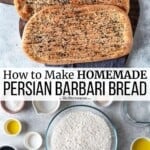
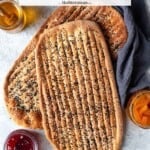
Learn how to make Barbari bread, a traditional Persian flatbread finished with sesame and nigella seeds. This easy homemade bread recipe looks stunning on the table and goes well with breakfast, lunch or dinner.
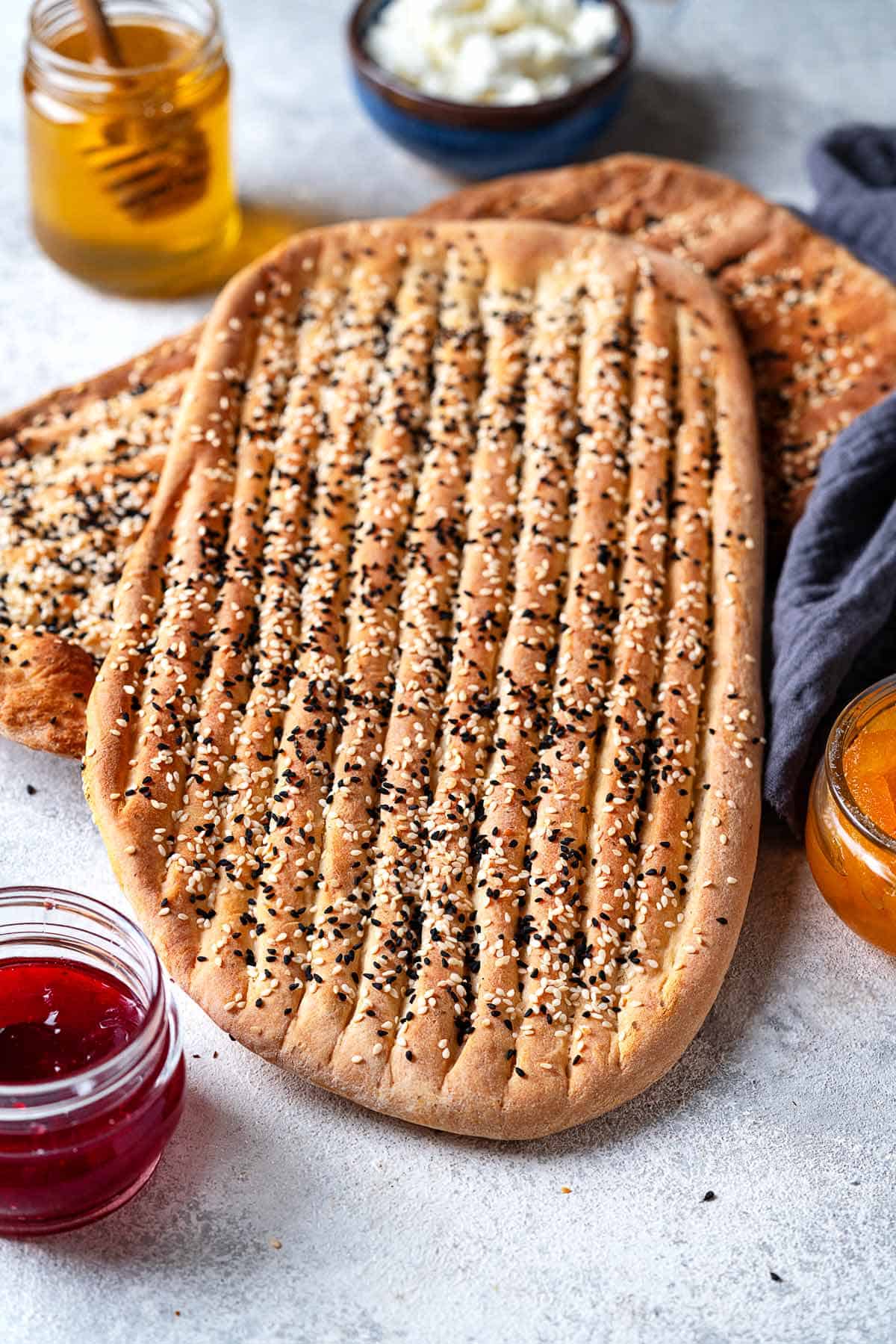
Barbari is an easy to make flatbread that’s a beloved staple of Persian cuisine. It’s aromatic and flavorful, with a soft, chewy texture and golden brown crust.
I typically like to serve barbari bread with savory dishes like Çılbır Turkish Poached Eggs in the morning, Easy Layered Hummus Dip for lunch or Chilled Cucumber Soup for dinner, but really it goes well with almost anything.
The surface of the bread is scored in a distinctive pattern, helping it bake perfectly and form an irresistible crust. Although, the dough takes a few hours to rise, it’s simple to make and well worth the extra time.
Plus, barbari bread freezes and reheats exceptionally well! I recommend making a big batch to keep on hand for when you crave homemade bread.
Table of Contents
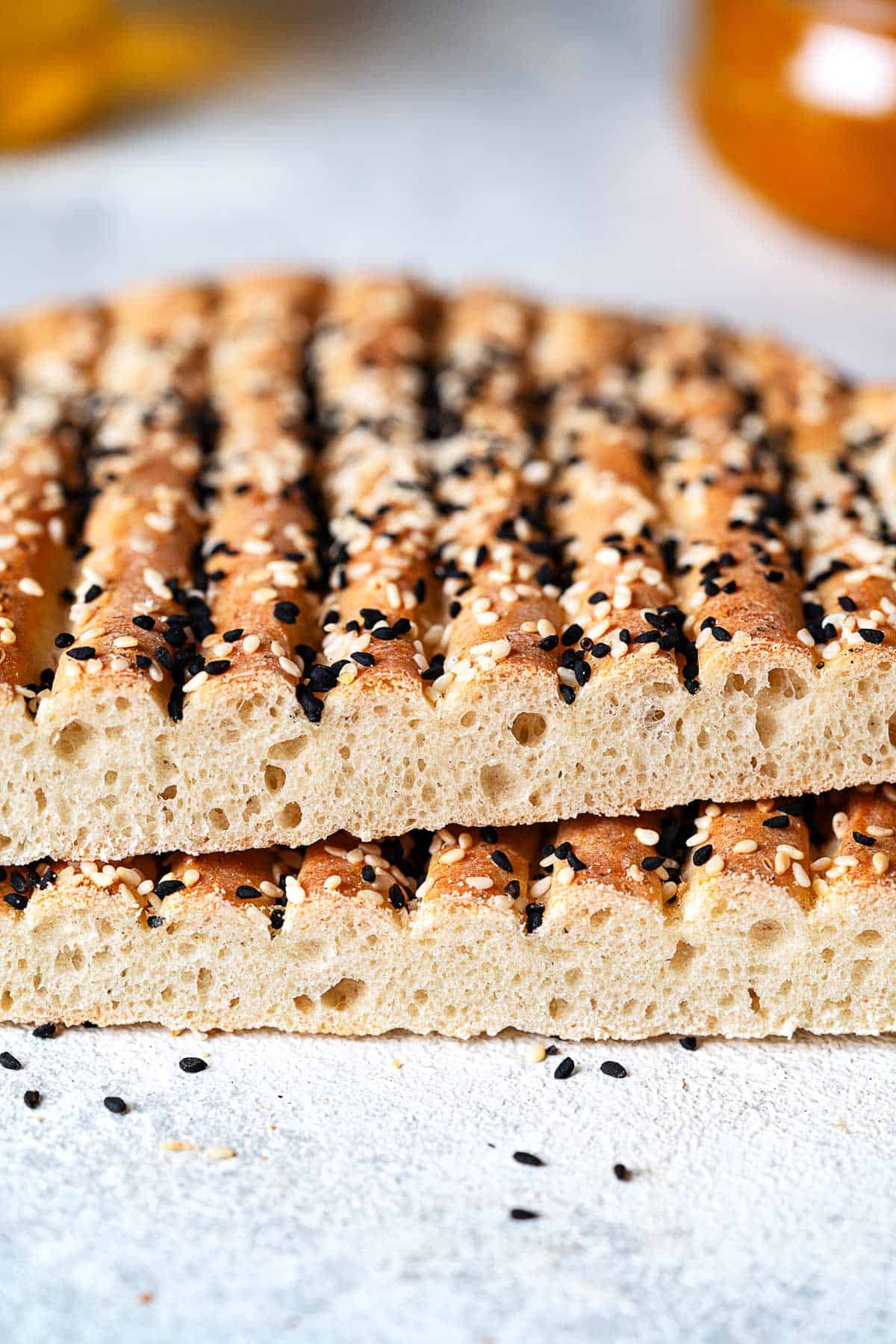
What is Barbari Bread?
Barbari bread or Nan-e Barbari, as it is named in Persian, is a yeast-leavened flatbread that’s glazed then topped with sesame and nigella seeds before baking. The glaze gives Barbari its distinctive golden-brown color and a nutty taste, similar to a pretzel.
Barbari bread is the most commonly eaten bread in Iran, where it’s traditionally served at breakfast with a feta-like cheese called Lighvan and jam. It is also served alongside dips, appetizers and main meals at lunch or dinner. Many servers at Persian restaurants will greet you at your table with a basket of warm Barbari bread.
Barbari is often baked commercially into 2 ½ feet-long oval pieces and folded into paper bags at bakeries. People then take the bread home and cut it into squares for toasting.
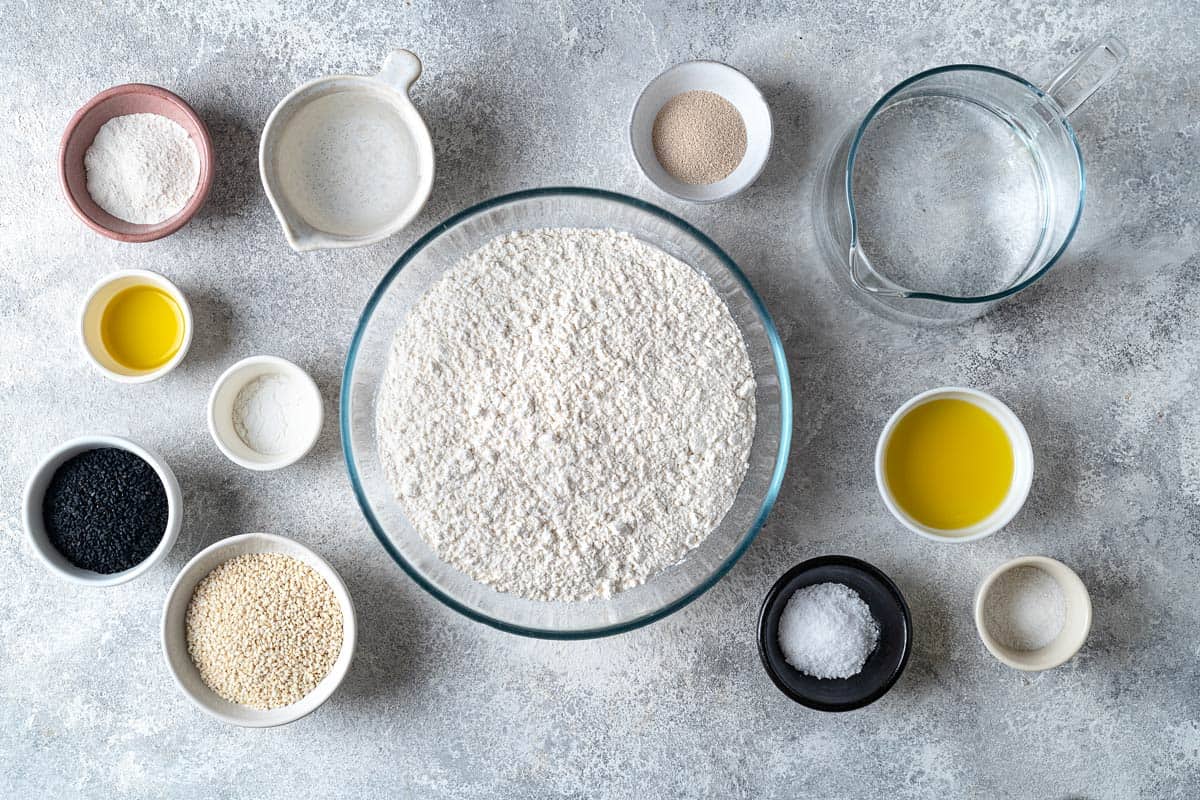
What You Need to Make Barbari Bread?
Barbari dough is made using the same ingredients as a standard loaf of bread. However, the distinct glaze and sesame and nigella seed topping transports one to the hustle and bustle of the cafes in Iran.
Most ingredients needed to make Barbari bread should be readily available at your local supermarket. If you can’t find nigella (also called Kalonji) seeds, try a Middle Eastern or South Asian supermarket, or specialty spice store. If you still can’t find nigella it’s OK to leave them off. The bread will still taste amazing.
- Active dry yeast: The leavening agent used to make the dough rise (see tips below for how to use active dry yeast).
- Sugar: A small amount of granulated sugar is used to help activate the yeast.
- Water: Used to activate the yeast. Make sure the water is lukewarm between 90°F and 110°F. Any hotter and you could kill the yeast. If you don’t have a thermometer, it should feel like bathwater to the touch.
- All-purpose flour: The most common flour available for baking in the US and it works perfectly for Barbari. If you are based in the UK like me, use strong white bread flour.
- Extra virgin olive oil: Used for the dough and for the glaze. A high quality olive oil, like our Private Reserve Greek Extra Virgin Olive Oil, goes a long way here in terms of flavor.
- Kosher salt: Used to flavor the bread, otherwise it will be very bland. If you need to substitute kosher salt with table salt, add half the amount.
- Baking powder: Mixed with water and flour over medium heat to create the glaze.
- Sesame and nigella seeds: Sprinkled on the bread before baking. While you’re likely familiar with the nutty flavor of sesame seeds, you may be wondering: what is a nigella seed? Sometimes called black cumin or Kalonji seeds, Nigella seeds are seeds of the nigella sativa, a flowering plant native to Turkey, Syria, and Iraq. They give the Barbari notes of pepper and onion.
How to Make Barbari Bread
This easy recipe sets out the steps for making barbari by hand, as you can easily make barbari bread without specialty equipment. If you have a stand mixer, you can also knead the bread with the dough hook on low speed.
Activate the Yeast: Combine 1 ⅓ cups of lukewarm water with 2 teaspoons of yeast and one teaspoon of sugar in a small measuring cup. Whisk, cover with a clean kitchen towel, and leave somewhere warm to activate the yeast, about 5-10 minutes. The yeast mixture should be bubbly and foamy. If it’s not foamy, give it 10 more minutes. If it never becomes foamy, your yeast may be expired or dead and you’ll need to pick up fresh yeast and try again.
Make the Dough: Add the flour, olive oil and salt to a large mixing bowl. Stir to combine, then make a well in the center. Add the yeast mixture and stir to form a shaggy dough.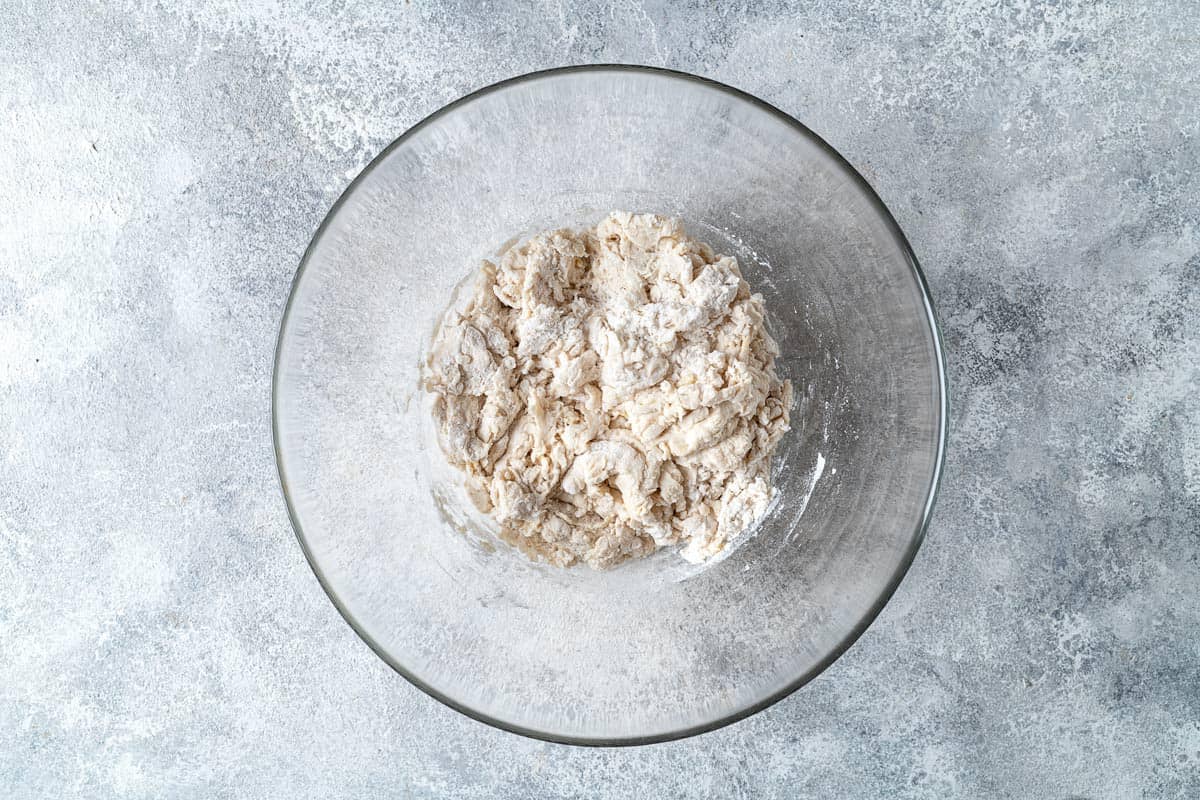
Knead the Dough: Sprinkle a little flour onto a clean surface and transfer the dough to the flour. Knead for 5-10 minutes, or until the dough becomes smooth and silky. Place the dough into a clean, oiled bowl. Cover with plastic wrap and leave in a warm, dark place for 1 hour, or until it has doubled in size.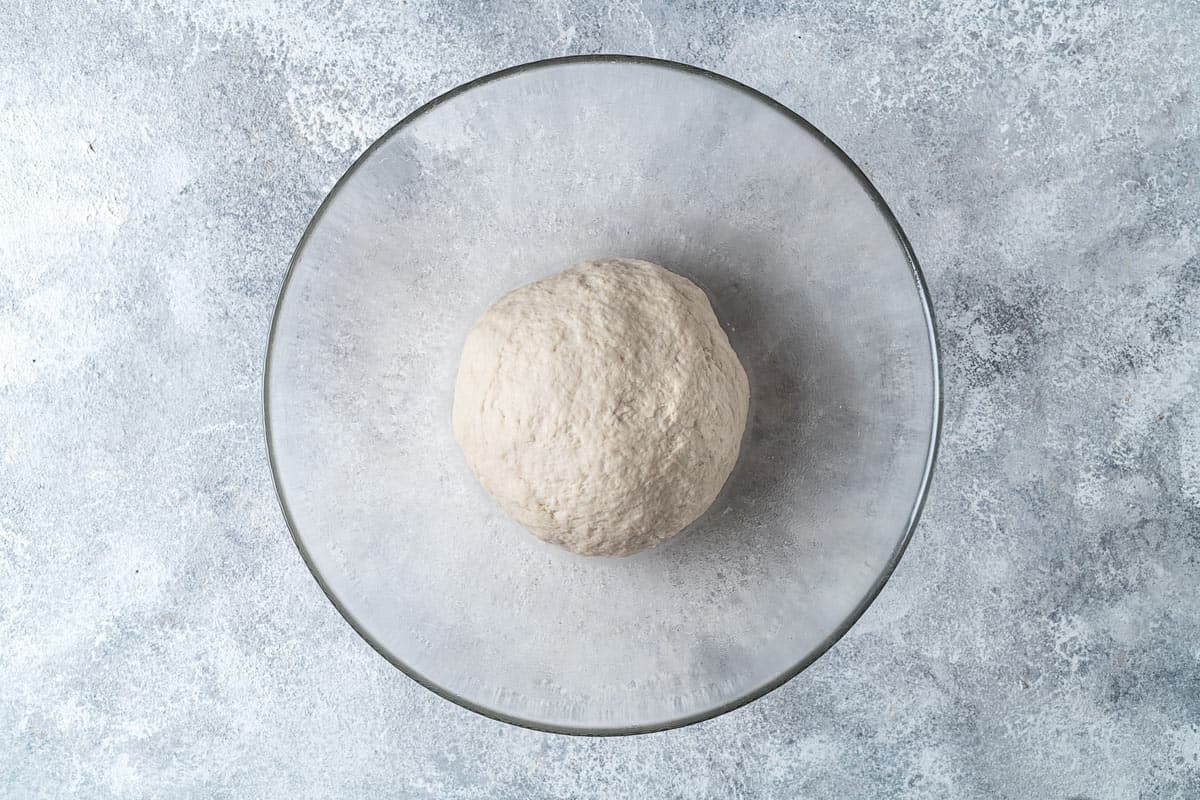
Prepare the Glaze: Place a small saucepan on medium-high heat. Add ⅓ cup water, 1 tablespoon flour, ½ teaspoon baking powder, and 1 teaspoon olive oil and stir until it forms a shiny white paste. Remove the glaze from the heat and set aside.
Knock Back and Divide the Dough: Once the dough has risen, place onto a floured surface. Punch into the center of the dough, then gently pinch the dough at the edges, pull into the center and push down until the large air pockets have escaped. Divide the dough into two even halves.
Shape the Barbari: Use a floured rolling pin to roll one half into an oblong shape, then hand-stretch it until it’s about 11-inches long and 8-inches wide. Place the shaped half on a parchment-lined baking tray. Using a sharp knife, lightly score along the length of the dough, about a finger-width apart. Use your fingers to push the dough down between the scored lines so you end up with small ridges, being careful not to push all the way through. Repeat with the remaining half of the dough and leave the bread to proof a second time for 30 minutes in a warm, dark place.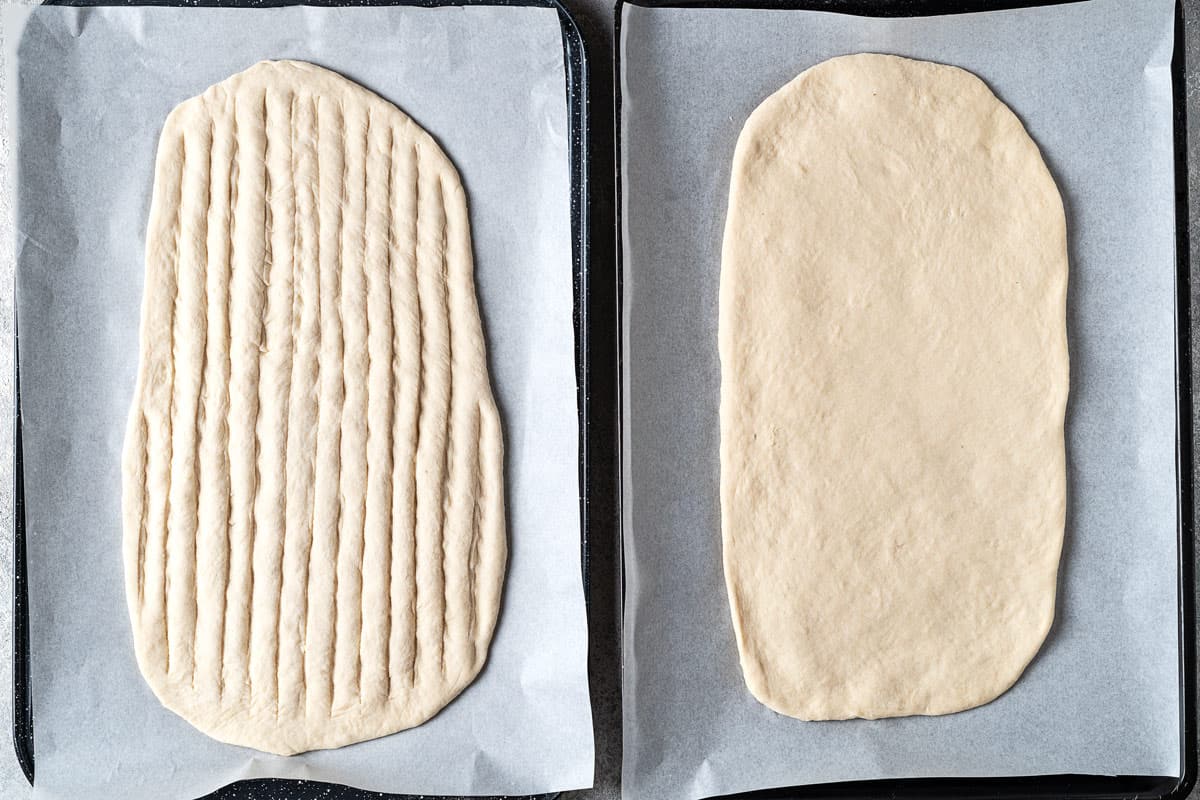
Glaze, Top and Bake the Barbari: Preheat your oven to 425°F. Brush each Barbari bread with the glaze. Use your fingers to define the ridges in the bread again, then top with sesame and nigella seeds. Bake until your barabari bread is golden, about 20 minutes.
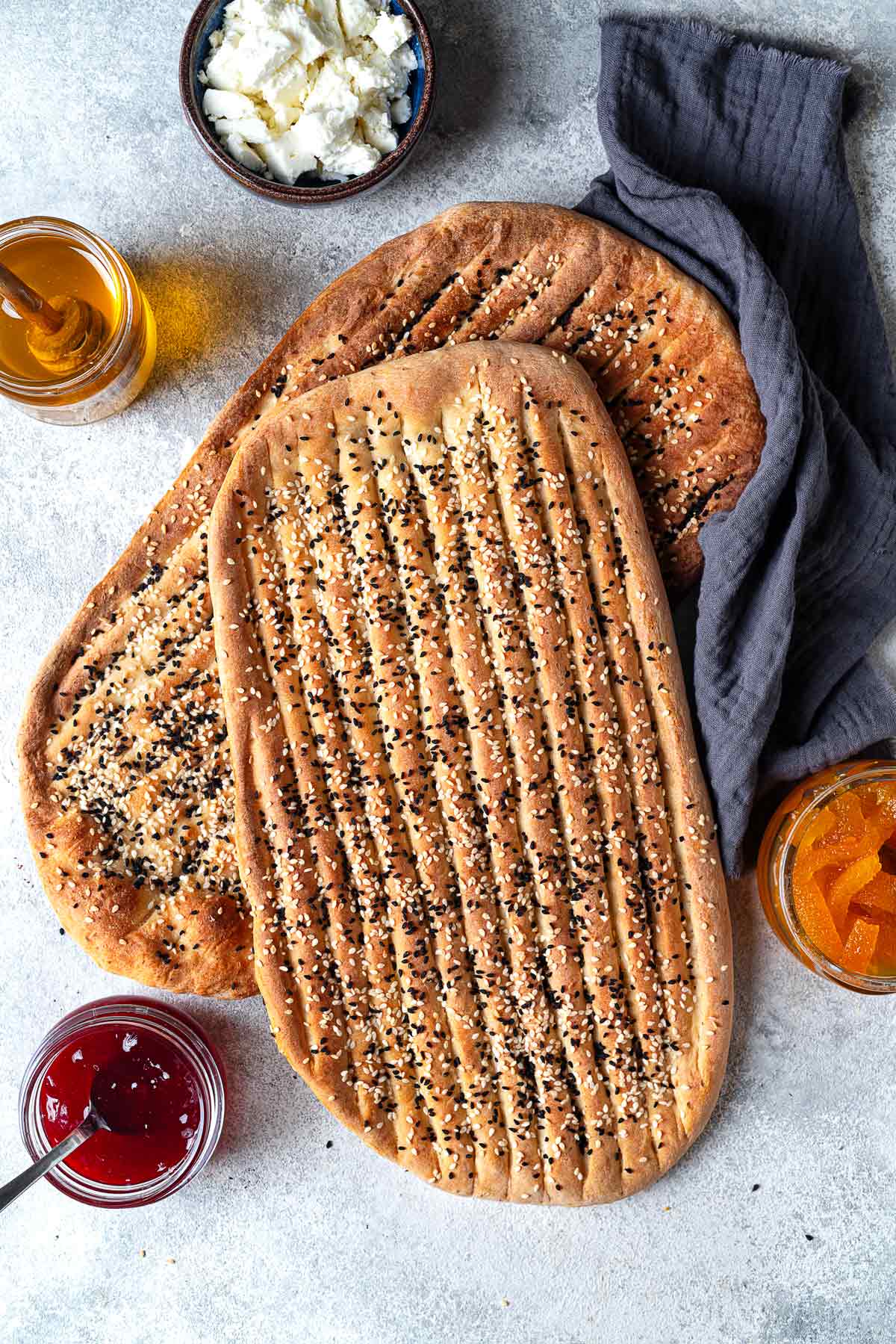
How to Serve Barbari Persian Flatbread
Iranians eat Barbari bread for breakfast with Lighvan cheese (similar to feta cheese), jams like rose petal or carrot, clotted cream, and honey–like our Alfa honey.
Barbari bread is also perfect forheartier egg-based breakfasts–it works especially well as a vessel for soaking up savory sauces, like the garlicky yogurt and chili oil of Çılbır Turkish Poached Eggs or the aromatic tomato sauce of Menemen Turkish Scrambled Eggs.
As delicious as Barbari is for breakfast, it’s truly amazing all day long. I love serving it with dips, like Easy Layered Hummus Dip or Baba Ganoush, as a snack, for lunch, or at a dinner party as a mezze. It’s also perfect on a hot summer day with a cooling soup, like this Persian-style Chilled Cucumber version.
How to Store Barbari
Homemade bread does not last as long as store bought as it doesn’t contain preservatives, so Barbari is best eaten the day it is baked. However, toasting it revives the Barbari.
To store homemade Barbari bread, cut the bread into square pieces and seal in an airtight bag or container. I store mine in the fridge or freezer and then toast it just before serving.
Other Homemade Bread Recipes We Love
Browse all Mediterranean recipes.
Visit Our Shop.
Bundle and Save!
Be sure to check out our Everyday EVOO Bundle — four signature branded olive oils that are perfect for everyday use.
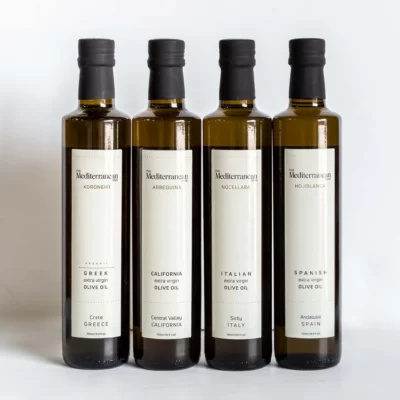
For the Dough
For the Glaze and Topping
-
Activate the Yeast: In a small measuring cup, combine 1 ⅓ cups lukewarm water (between 90°F and 110°F) with the yeast and sugar. Whisk, cover with a clean kitchen towel and leave somewhere warm for 15 minutes to activate the yeast.
-
Make the Dough: In a large mixing bowl, whisk together the flour, olive oil, and salt. Stir to combine, then make a well in the center. Add the yeast mixture and stir to form a shaggy dough.
-
Knead the Dough: Sprinkle a little flour onto a clean surface and lay the dough on the flour. Knead for 5-10 minutes, or until the dough becomes smooth and silky. Place dough into a clean, oiled bowl. Cover with plastic wrap and leave in a warm, dark place for 1 hour, or until it has doubled in size.
-
Prepare the Glaze: Place a small saucepan on medium-high heat. Add the water, flour, baking powder, and olive oil and stir until it forms a shiny white paste. Remove from the heat and set aside until you are ready to glaze prior to baking.
-
Knock Back and Divide the Dough: Once the dough has risen, place the dough onto a floured surface. Punch into the center of the dough, then gently pinch the dough at the edges, pull into the center and push down until the large air pockets have escaped. Divide the dough into two even halves.
-
Shape the Barbari: Use a floured rolling pin to roll one half into an oblong shape, then hand-stretch it until it’s about 11-inches long and 8-inches wide. Place the shaped half on a parchment-lined baking tray. Use a sharp knife and lightly score along the length of the dough, about a finger-width apart. Use your fingers to push the dough down between the scored lines so you end up with small ridges, being careful not to push all the way through. Repeat with the remaining half of the dough and leave the bread to proof a second time for 30 minutes in a warm, and dark place.
-
Preheat Oven: Preheat the oven to 425°F.
-
Glaze, Top and Bake the Barbari: Preheat your oven to 425°F. Brush each of the Barbari breads with the glaze. Use your fingers to define the ridges in the bread again, then top with sesame and nigella seeds. Bake until your barabari bread is golden, about 20 minutes.
- Visit our shop to browse quality Mediterranean ingredients including olive oils, honey, jams and spices.
- If your yeast isn’t bubbly after activating it in water, let sit for another 10-15 minutes and check on it again. If it’s still not foamy, your yeast might be bad, in which case the best option is to buy some new yeast at the store and try again.
- To check the rise of your bread, you can use a piece of masking tape on the outside of your mixing bowl to mark the top of your bread before proofing.
Calories: 203.1kcalCarbohydrates: 37.6gProtein: 6.3gFat: 2.7gSaturated Fat: 0.4gPolyunsaturated Fat: 0.6gMonounsaturated Fat: 1.4gSodium: 489.7mgPotassium: 57.6mgFiber: 1.4gSugar: 0.6gVitamin A: 1IUVitamin C: 0.002mgCalcium: 21.1mgIron: 0.5mg
"bread" - Google News
March 03, 2023 at 02:07AM
https://ift.tt/bLJrK13
Barbari Bread (Persian Flatbread) - The Mediterranean Dish
"bread" - Google News
https://ift.tt/4PSNYWK
https://ift.tt/GKJaUxj
Bagikan Berita Ini














0 Response to "Barbari Bread (Persian Flatbread) - The Mediterranean Dish"
Post a Comment